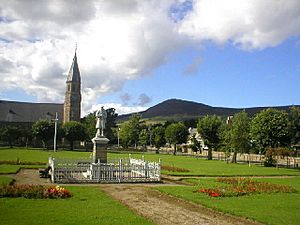Rhynie facts for kids
Rhynie (Scottish Gaelic: Roinnidh) is a small village in Aberdeenshire, Scotland. It is about 14 miles northwest of Alford.
Rhynie is well-known for a special type of rock called the Rhynie chert. This rock is a sedimentary rock. It formed during the Devonian period, which was millions of years ago. The Rhynie chert is very important because it contains the oldest fossil insect ever found in the world. An extinct plant genus called Rhynia is also named after the village.
Contents
Discovering Ancient Fossils
The Rhynie chert is a unique rock. It formed when hot springs covered plants and tiny animals. This quickly preserved them. Scientists can study these fossils to learn about life long ago. The chert shows a very early land ecosystem. It includes ancient plants, fungi, and the oldest known insect. This makes Rhynie a key place for understanding Earth's history.
A Look into Rhynie's History
Many interesting things have been found in Rhynie. Eight special stones called Pictish symbol stones were discovered here. The Picts were an ancient people in Scotland. These stones have unique carvings.
The Rhynie Man
One of the most famous finds is the "Rhynie Man." It was found in 1978. This is a large boulder, about six feet tall. It has a carving of a bearded man. The man is holding an axe. Some people think it might be a carving of an ancient Celtic god named Esus. Today, the "Rhynie Man" is kept safe inside Woodhill House. This building is in Aberdeen. It is the main office for the Aberdeenshire Council.
Uncovering an Old Settlement
In 2011, archaeologists started digging near where the "Rhynie Man" was found. They discovered an old settlement. This settlement was fortified, meaning it had strong walls for protection. It dates back to the early medieval period. This was a time between the 5th and 15th centuries.
Among the things found were pieces of a Roman amphora. An amphora is a type of jar. This jar was from the late 5th or 6th century. It is the only known Roman amphora from Eastern Britain from after the Roman period. This jar must have been imported from the Mediterranean region. This suggests that the people living in the settlement were very important. Archaeologists believe the settlement might have been a royal family site. It could have been a place where Pictish kings lived.



